Characteristics of Lightweight Concrete Based on a Synthetic Polymer Foaming Agent
Abstract
1. Introduction
2. Materials
2.1. Specimen Preparation
2.2. Mix Composition
2.3. Mix Production
3. Methodology
3.1. General Information
3.2. Density
3.3. Distribution of Pores
3.4. Compressive Strength
3.5. Creep Deformation
- εc(t)—creep deformation in time t;
- εtot(t)—total measured creep deformation of foamed concrete sample long-term loading in time t;
- εa—immediate strain determined after 5 min of obtaining 1/3 of compressive strength;
- εs(t)—shrinkage in time t.
- εs—shrinkage in i-period;
- l0, lt—initial distance between measuring points and distance after a specified curing time.
4. Results and Discussion
4.1. Density
4.2. Distribution of Pores
4.3. Compressive Strength
4.4. Creep Deformation
5. Conclusions
- The density of hardened foamed concrete was 970 ± 30, 800 ± 30, 720 ± 20 and 550 ± 20 kg/m3 for foaming agent content of 4.0, 5.0, 6.0 and 8.0 dm3 per 100 kg of cement, respectively. The volume of foam commonly created air-voids and resulted in lower density.
- The differences between the density of the mixture and the density of the hardened sample were up to 170 kg/m3 depending on the density of foamed concrete samples; larger differences were demonstrated for higher densities. In this way, the difference between the density of the mixture and the hardened foamed concrete was obtained in order to design the mixture with the target parameters.
- Foamed concrete with a density of 700 and 800 kg/m3 had similar characteristics of pores, such as number, area, perimeter and shape descriptors (circularity, roundness and solidity). It can be observed that the size of pores was from 0.26 to even 3.45 mm for foamed concrete with a density of 700 kg/m3, while the average size of pores for foamed concrete with a density of 500 kg/m3 was from 0.43 to 0.65 mm.
- The number of air-voids for foamed concrete with a density of 500 kg/m3 was greater and the average thickness of air bubbles wall was thinner than for the other densities.
- Specimens with a density of around 700 and 800 kg/m3 had smaller air-voids, but more large air bubbles up to 3.5 mm in diameter were observed by higher density.
- With the addition of foaming agent of 8.0, 6.0, 5.0 and 4.0 dm3 per 100 kg of cement, the compressive strength was equal to 5.9 ± 0.2, 5.1 ± 0.2, 3.8 ± 0.3 and 1.4 ± 0.2 MPa, respectively. The obtained compressive strengths were higher than those found in the literature for the same densities. This was most likely related to the fact that the synthetic foaming agent contained a stabilizer foam.
- With increasing density of foamed concrete, smaller creep deformations were obtained. Creep deformations were 509, 495 and 455 με for samples with density of around 500, 700 and 1000 kg/m3. Deformation under long-term loading took place up to 90 days, regardless of the density of the foamed concrete.
Author Contributions
Funding
Acknowledgments
Conflicts of Interest
References
- Zhang, X.-P.; Cheng, X.-M. Energy consumption, carbon emissions, and economic growth in China. Ecol. Econ. 2009, 68, 2706–2712. [Google Scholar] [CrossRef]
- Arouri, M.E.H.; Youssef, A.B.; M’henni, H.; Rault, C. Energy consumption, economic growth and CO2 emissions in Middle East and North African countries. Energy Policy 2012, 45, 342–349. [Google Scholar] [CrossRef]
- Jaunky, V.C. The CO2 emissions-income nexus: Evidence from rich countries. Energy Policy 2011, 39, 1228–1240. [Google Scholar] [CrossRef]
- Lapinskienė, G.; Peleckis, K.; Slavinskaite, N. Energy consumption, economic growth and greenhouse gas emissions in the European Union countries. J. Bus. Econ. Manag. 2017, 18, 1082–1097. [Google Scholar] [CrossRef]
- Sterpu, M.; Soava, G.; Mehedintu, A. Impact of Economic Growth and Energy Consumption on Greenhouse Gas Emissions: Testing Environmental Curves Hypotheses on EU Countries. Sustainability 2018, 10, 3327. [Google Scholar] [CrossRef]
- European Commission (CE). Energy Roadmap 2050 Impact Assessment and Scenario Analysis. 2011. Available online: https://ec.europa.eu/energy/sites/ener/files/documents/roadmap2050_ia_20120430_en_0.pdf (accessed on 27 September 2020).
- Pan, Z.; Li, H.; Liu, W. Preparation and characterization of super low density foamed concrete from Portland cement and admixtures. Constr. Build. Mater. 2014, 72, 256–261. [Google Scholar] [CrossRef]
- Amran, Y.H.M.; Farzadnia, N.; Ali, A.A.A. Properties and applications of foamed concrete: A review. Constr. Build. Mater. 2015, 101, 990–1005. [Google Scholar] [CrossRef]
- Nambiar, E.K.; Ramamurthy, K. Air-void characterization of foam concrete. Cem. Concr. Res. 2007, 37, 221–230. [Google Scholar] [CrossRef]
- Raj, A.; Sathyan, D.; Mini, K.M. Physical and functional characteristics of foam concrete: A review. Constr. Build. Mater. 2019, 221, 787–799. [Google Scholar] [CrossRef]
- Fu, Y.; Wang, X.; Wang, L.; Li, Y. Foam concrete: A state-of-the-art and state-of-the-practice review. Adv. Mater. Sci. Eng. 2020, 2020, 6153602. [Google Scholar] [CrossRef]
- Ramamurthy, K.; Nambiar, E.K.; Ranjani, G.I.S. A classification of studies on properties of foam concrete. Cem. Concr. Compos. 2009, 31, 388–396. [Google Scholar] [CrossRef]
- Dhir, R.K.; Newlands, M.D.; McCarthy, A. Use of Foamed Concrete in Construction: Proceedings of the Conference Held at the University of Dundee, Scotland, UK, on 5 July 2005; Thomas Telford: Dundee, UK, 2005. [Google Scholar]
- Hilal, A.A.; Thom, N.H.; Dawson, A.R. On entrained pore size distribution of foamed concrete. Constr. Build. Mater. 2015, 75, 227–233. [Google Scholar] [CrossRef]
- Alonge, O.R.; Mahyuddin, R. Experimental production of sustainable lightweight foamed concrete. Br. J. Appl. Sci. Technol. 2013, 3, 994–1005. [Google Scholar] [CrossRef]
- Hajimohammadi, A.; Ngo, T.; Mendis, P. Enhancing the strength of pre-made foams for foam concrete. Cem. Concr. Compos. 2018, 87, 164–171. [Google Scholar] [CrossRef]
- Dissanayake, D.M.K.W.; Jayasinghe, C.; Jayasinghe, M.T.R. A comparative embodied energy analysis of a house with recycled expanded polystyrene (EPS) based foam concrete wall panels. Energy Build. 2017, 135, 85–94. [Google Scholar] [CrossRef]
- Zahari, N.M.; Rahman, I.A.; Zaidi, A.M.A. Foamed concrete: Potential application in thermal insulation. In Proceedings of the MUCEET2009 Malaysian Technical Universities Conference on Engineering and Technology, MS Garden, Kuantan, Malaysia, 20–22 June 2009; pp. 47–52. Available online: https://pdfs.semanticscholar.org/f952/c92c86ca2bbee2d282a269d25f6f75732eab.pdf?_ga=2.162112444.160126985.1586034381-204925583.1582726913 (accessed on 27 September 2020).
- Huang, Z.; Zhang, T.; Wen, Z. Proportioning and characterization of Portland cement-based ultra-lightweight foamed concretes. Constr. Build. Mater. 2015, 79, 390–396. [Google Scholar] [CrossRef]
- Zhang, Z.; Provis, J.I.; Reid, A.; Wang, H. Mechanical, thermal insulation, thermal resistance and acoustic absorption properties of geopolymer foam concrete. Cem. Concr. Compos. 2009, 62, 97–105. [Google Scholar] [CrossRef]
- Kearsley, E.P.; Wainwright, P.J. The effect of porosity on the strength of foamed concrete. Cem. Concr. Res. 2002, 32, 233–239. [Google Scholar] [CrossRef]
- Chindaprasirt, P.; Rattanasak, U. Shrinkage behavior of structural foam lightweight concrete containing glycol compounds and fly ash. Mater. Des. 2011, 32, 723–727. [Google Scholar] [CrossRef]
- Cox, L.S.; Van Djijk, S. Foam concrete: A different kind of mix. Concrete 2002, 36, 54–55. [Google Scholar]
- Weigler, H.; Karl, S. Structural lightweight aggregate concrete with reduced density—Lightweight aggregate foamed concrete. Int. J. Cem. Comp. Light. Concr. 1980, 2, 101–104. [Google Scholar] [CrossRef]
- Mydin, M.A.O.; Wang, Y.C. Structural performance of lightweight steel-foamed concrete–steel composite walling system under compression. Thin-Wall. Struct. 2011, 49, 66–76. [Google Scholar] [CrossRef]
- Jones, M.R.; McCarthy, A. Preliminary views on the potential of foamed concrete as a structural material. Mag. Concr. Res. 2005, 57, 21–31. [Google Scholar] [CrossRef]
- Amran, Y.H.M.; Ali, A.A.A.; Rashid, R.S.M.; Hejazi, F.; Safiee, N.A. Structural behavior of axially loaded precast foamed concrete sandwich panels. Constr. Build. Mater. 2016, 107, 307–320. [Google Scholar] [CrossRef]
- Fadila, R.; Suleiman, M.Z.; Noordin, N.M. Paper fiber reinforced foam concrete wall paneling system. In Proceedings of the 2nd International conference on built environment in developing countries (ICBEDC 2008), Penang, Malaysia, 3–4 December 2008; Available online: https://pdfs.semanticscholar.org/7101/7e911ed728bc645ebb829db413cdf0ed5648.pdf (accessed on 27 September 2020).
- Kang, J. Composite and non-composite behaviors of foam-insulated concrete sandwich panels. Compos. Part B Eng. 2015, 68, 153–161. [Google Scholar] [CrossRef]
- Fernando, P.L.N.; Jayasinghe, M.T.R.; Jayasinghe, C. Structural feasibility of Expanded Polystyrene (EPS) based lightweight concrete sandwich wall panels. Constr. Build. Mater. 2017, 139, 45–51. [Google Scholar] [CrossRef]
- Portal, N.W.; Flansbjer, M.; Zandia, K.; Wlasak, L.; Malaga, K. Bending behaviour of novel Textile Reinforced Concrete-foamed concrete (TRC-FC) sandwich elements. Comp. Struct. 2017, 177, 104–118. [Google Scholar] [CrossRef]
- Rum, R.H.M.; Jaini, Z.M.; Abd Ghafar, N.H.; Abd Rahman, N. A preliminary experimental study on vibration responses of foamed concrete composite slabs. IOP Conf. Ser. Mater. Sci. Eng. 2017, 271, 12102. [Google Scholar] [CrossRef]
- Fedorowicz, L.; Kadela, M. Foamed concrete used a subbase for some systems structure-subsoil. In Proceedings of the 7th Congress Inžinierska Geológia 2012 Engineering Geology 2012, Nový Smokovec, Slovakia, 14–15 June 2012. [Google Scholar]
- Kadela, M.; Kozłowski, M.; Kukiełka, A. Application of foamed concrete in road pavement–weak soil system. Proc. Eng. 2017, 193, 439–446. [Google Scholar] [CrossRef]
- Kadela, M.; Kozłowski, M. Foamed concrete layer as sub-structure of industrial concrete floor. Proc. Eng. 2016, 161, 468–476. [Google Scholar] [CrossRef]
- Drusa, M.; Fedorowicz, L.; Kadela, M.; Scherfel, W. Application of geotechnical models in the description of composite foamed concrete used in contact layer with the subsoil. In Proceedings of the 10th Slovak Geotechnical Conference—Geotechnical Problems of Engineering Constructions, Bratislava, Slovakia, 30–31 May 2011. [Google Scholar]
- Decký, M.; Drusa, M.; Zgútová, K.; Blaško, M.; Hájek, M.; Scherfel, W. Foam concrete as new material in road constructions. Proc. Eng. 2016, 161, 428–433. [Google Scholar] [CrossRef]
- Vlcek, J.; Drusa, M.; Scherfel, W.; Sedlar, B. Experimental Investigation of properties of foam concrete for industrial floors in testing field. IOP Conf. Ser. Earth Environ. Sci. 2017, 95, 22049. [Google Scholar] [CrossRef]
- Tian, W.; Li, L.; Zhao, X.; Zhou, M.; Wamg, N. Application of foamed concret in road engineering. In Proceedings of the International Conference on Transportation Engineering ICTE 2009, Chengdu, China, 25–27 July 2009. [Google Scholar]
- Lee, Y.L.; Goh, K.S.; Koh, H.B.; Ismail, B. Foamed aggregate pervious concrete—an option for road on peat. In Proceedings of the Malaysian Technical Universities Conference on Engineering and Technology (MUCEET 2009), MS Garden, Kuantan, Malaysia, 20–22 June 2009. [Google Scholar]
- Pokorska-Silva, I.; Kadela, M.; Fedorowicz, L. A reliable numerical model for assessing the thermal behavior of a dome building. J. Build. Eng. 2020, 32, 101706. [Google Scholar] [CrossRef]
- Awang, H.; Al-Mulali, M. Strength of sieved only oil palm ash foamed concrete. Int. J. Eng. Technol. 2016, 8, 354–357. [Google Scholar] [CrossRef]
- Wu, H.C.; Sun, P. New building materials from fly ash-based lightweight inorganic polymer. Constr. Build. Mater. 2007, 21, 211–217. [Google Scholar] [CrossRef]
- Sarmin, S.N. Lightweight Building Materials of Geopolymer Reinforced Wood Particles Aggregate—A Review. Appl. Mech. Mater. 2015, 802, 220–224. [Google Scholar] [CrossRef]
- Neville, A.M. Properties of Concrete, 2nd ed.; Pitman: London, UK, 1973. [Google Scholar]
- Li, T.; Huang, F.; Zhu, J.; Tang, J.; Liu, J. Effect of foaming gas and cement type on the thermal conductivity of foamed concrete. Constr. Build. Mater. 2020, 231, 117197. [Google Scholar] [CrossRef]
- Ma, C.; Chen, B. Experimental study on the preparation and properties of a novel foamed concrete based on magnesium phosphate cement. Constr. Build. Mater. 2017, 137, 160–168. [Google Scholar] [CrossRef]
- Ghorbani, S.; Ghorbani, S.; Tao, Z.; de Brito, J.; Tavakkolizadeh, M. Effect of magnetized water on foam stability and compressive strength of foam concrete. Constr. Build. Mater. 2019, 197, 280–290. [Google Scholar] [CrossRef]
- Ma, C.; Chen, B. Properties of foamed concrete containing water repellents. Constr. Build. Mater. 2016, 123, 106–114. [Google Scholar] [CrossRef]
- Kearsley, E.P.; Wainwright, P.J. Porosity and permeability of foamed concrete. Cem. Concr. Res. 2001, 31, 805–812. [Google Scholar] [CrossRef]
- Oren, O.H.; Gholampour, A.; Gencel, O.; Ozbakkaloglu, T. Physical and mechanical properties of foam concretes containing granulated blast furnace slag as fine aggregate. Constr. Build. Mater. 2020, 238, 117774. [Google Scholar] [CrossRef]
- Kolias, S.; Georgiou, C. The effect of paste volume and of water content on the strength and water absorption of concrete. Cem. Concr. Compos. 2005, 27, 211–216. [Google Scholar] [CrossRef]
- Awang, H.; Mydin, M.A.O.; Farhan, R.A. Effect of additives on mechanical and thermal properties of lightweight foamed concrete. Adv. Appl. Sci. Res. 2012, 3, 3326–3338. [Google Scholar]
- Hilal, A.A.; Thom, N.H.; Dawson, A.R. The Use of Additives to Enhance Properties of PreFormed Foamed Concrete. Int. J. Eng. Technol. 2015, 7. [Google Scholar] [CrossRef]
- Pan, Z.; Hiromi, F.; Wee, T. Preparation of high performance foamed concrete from cement, sand and mineral admixtures. J. Wuhan Univ. Technol. 2007, 22, 295–298. [Google Scholar] [CrossRef]
- Chen, B.; Liu, J. Experimental application of mineral admixtures in lightweight concrete with high strength and workability. Constr. Build. Mater. 2008, 22, 655–659. [Google Scholar] [CrossRef]
- Kadela, M.; Kukiełka, A. Influence of foaming agent content in fresh concrete on elasticity modulus of hard foam concrete. In Proceedings of the 11th International Symposium on Brittle Matrix Composites BMC 2015, Warsaw, Poland, 12–14 October 2015; pp. 489–496. [Google Scholar]
- Kearsley, E.P.; Wainwright, P.J. The effect of high fly ash content on the compressive strength of foamed concrete. Cem. Concr. Res. 2001, 31, 105–112. [Google Scholar] [CrossRef]
- Kozłowski, M.; Kadela, M. Mechanical Characterization of Lightweight Foamed Concrete. Adv. Mater. Sci. Eng. 2018, 2018, 6801258. [Google Scholar] [CrossRef]
- Kozlowski, M.; Kadela, M. Experimental and Numerical Investigation of Fracture Behavior of Foamed Concrete Based on Three-Point Bending Test of Beams with Initial Notch. In Proceedings of the ICMCME 2015: International Conference on Mechanical, Civil and Material Engineering, Barcelona, Spain, 17–18 August 2015; p. 943. [Google Scholar] [CrossRef]
- Amran, Y.H.M.; Alyousef, R.; Alabduljabbar, H.; Khudhair, M.H.R.; Hejazi, F.; Alaskar, A.; Alrshoudi, A.; Siddika, A. Performance properties of structural fibred-foamed concrete. Res. Eng. 2020, 5, 100092. [Google Scholar] [CrossRef]
- Zhu, H.; Chen, L.; Xu, J.; Han, Q. Experimental study on performance improvement of anionic surfactant foaming agent by xanthan gum. Constr. Build. Mater. 2020, 230, 116993. [Google Scholar] [CrossRef]
- Ghorbani, S.; Sharifi, S.; de Brito, J.; Ghorbani, S.; Jalayer, M.A.; Tavakkolizadeh, M. Using statistical analysis and laboratory testing to evaluate the effect of magnetized water on the stability of foaming agents and foam concrete. Constr. Build. Mater. 2019, 207, 28–40. [Google Scholar] [CrossRef]
- Kuzielová, E.; Pach, L.; Palou, M. Effect of activated foaming agent on the foam concrete properties. Constr. Build. Mater. 2016, 125, 998–1004. [Google Scholar] [CrossRef]
- Falliano, D.; De Domenico, D.; Ricciardi, G.; Gugliandolo, E. Experimental investigation on the compressive strength of foamed concrete: Effect of curing conditions, cement type, foaming agent and dry density. Constr. Build. Mater. 2018, 165, 735–749. [Google Scholar] [CrossRef]
- Liu, X.; Wang, S.; Li, S.; Wang, J. Study on high-efficiency complexed foaming agent for lightweight foamed concrete. Adv. Mater. Res. 2011, 250–253, 569–573. [Google Scholar] [CrossRef]
- She, W.; Du, Y.; Miao, C.; Liu, J.; Zhao, G.; Jiang, J.; Zhang, Y. Application of organic- and nanoparticle-modified foams in foamed concrete: Reinforcement and stabilization mechanisms. Cem. Concr. Res. 2018, 106, 12–22. [Google Scholar] [CrossRef]
- Czarnecki, L.; Łukowski, P. Polymer-cement concretes. Cem. Wapno Beton 2010, 15, 243–258. [Google Scholar]
- Wang, R.; Li, J.; Zhang, T.; Czarnecki, L. Chemical interaction between polymer and cement in polymer-cement concrete. Bull. Pol. Acad. Sci. Tech. Sci. 2016, 64, 785–792. [Google Scholar] [CrossRef]
- Zalegowski, K.; Piotrowski, T.; Garbacz, A. Influence of polymer modification on the microstructure of shielding concrete. Materials 2020, 13, 498. [Google Scholar] [CrossRef]
- Panesar, D.K. Cellular concrete properties and the effect of synthetic and protein foaming agents. Constr. Build. Mater. 2013, 44, 575–584. [Google Scholar] [CrossRef]
- Amran, Y.H.M.; Rashid, R.S.M.; Hejazi, F.; Safiee, N.A.; Ali, A.A.A. Response of precast foamed concrete sandwich panels to flexural loading. J. Build. Eng. 2016, 7, 143–158. [Google Scholar] [CrossRef]
- Jiang, J.; Lu, Z.; Niu, Y.; Li, J.; Zhang, Y. Study on the preparation and properties of high-porosity foamed concretes based on ordinary Portland cement. Mater. Des. 2016, 92, 949–959. [Google Scholar] [CrossRef]
- Chen, B.; Liu, N. A novel lightweight concrete-fabrication and its thermal and mechanical properties. Constr. Build. Mater. 2013, 44, 691–698. [Google Scholar] [CrossRef]
- Sun, C.; Zhu, Y.; Guo, J.; Zhang, Y.; Sun, G. Effects of foaming agent type on the workability, drying shrinkage, frost resistance and pore distribution of foamed concrete. Constr. Build. Mater. 2018, 186, 833–839. [Google Scholar] [CrossRef]
- Tan, X.; Chen, W.; Hao, Y.; Wang, X. Experimental study of ultralight (<300 kg/m3) foamed concrete. Adv. Mater. Sci. Eng. 2014, 2014, 514759. [Google Scholar] [CrossRef]
- Kozłowski, M.; Kadela, M.; Kukiełka, A. Fracture energy of foamed concrete based on three-point bending test on notched beams. Proc. Eng. 2015, 108, 349–354. [Google Scholar] [CrossRef]
- Kadela, M.; Kozłowski, M. Degradation analysis of notched foam concrete beam. Appl. Mech. Mater. 2015, 797, 96–100. [Google Scholar] [CrossRef]
- Kozłowski, M.; Kadela, M. Combined Experimental and Numerical Study on Fracture Behaviour of Low–Density Foamed Concrete. IOP Conf. Ser. Mater. Sci. Eng. 2018, 324, 12031. [Google Scholar] [CrossRef]
- Yu, W.; Liang, X.; Ni, F.M.-W.; Oyeyi, A.G.; Tighe, S. Characteristics of Lightweight Cellular Concrete and Effects on Mechanical Properties. Materials 2020, 13, 2678. [Google Scholar] [CrossRef]
- Waheed, A.; Arshid, M.U.; Mehboob, S.; Ahmed, A.; Sultan, T. Preparation of low-cost foam concrete using detergent. Tech. J. 2019, 24, 1–7. [Google Scholar]
- Wan, K.T.; Zhu, H.; Yuen, T.Y.P.; Chen, B.; Hu, C.; Leung, C.K.Y.; Kuang, J.S. Development of low drying shrinkage foamed concrete and hygro-mechanical finite element model for prefabricated building fasçade applications. Constr. Build. Mater. 2018, 165, 939–957. [Google Scholar] [CrossRef]
- Castillo-Lara, J.F.; Flores-Johnson, E.A.; Valadez-Gonzalez, A.; Herrera-Franco, P.J.; Carrillo, J.G.; Gonzalez-Chi, P.I.; Li, Q.M. Mechanical Properties of Natural Fiber Reinforced Foamed Concrete. Materials 2020, 13, 3060. [Google Scholar] [CrossRef]
- Gonzenbach, U.T.; Studart, A.R.; Tervoort, E.; Gauckler, L.J. Stabilization of foams with inorganic colloidal particles. Langmuir 2006, 22, 10983–10988. [Google Scholar] [CrossRef]
- Zia, P.; Ahmad, S.; Leming, M. High-Performance Concretes, a State-of-Art Report (1989-0994); FHWA-RD-97-030; Federal Highway Administration: McLean, VA, USA, 1997.
- American Concrete Institute. Report on Factors Affecting Shinkage and Creep of Hardened Concrete; ACI 209.1R-05; American Concrete Institute: Farmington Hills, MI, USA, 2005. [Google Scholar]
- Nambiar, E.K.; Ramamurthy, K. Shrinkage behawior of foam concrete. J. Mater. Civ. Eng. 2009, 21, 631–636. [Google Scholar] [CrossRef]



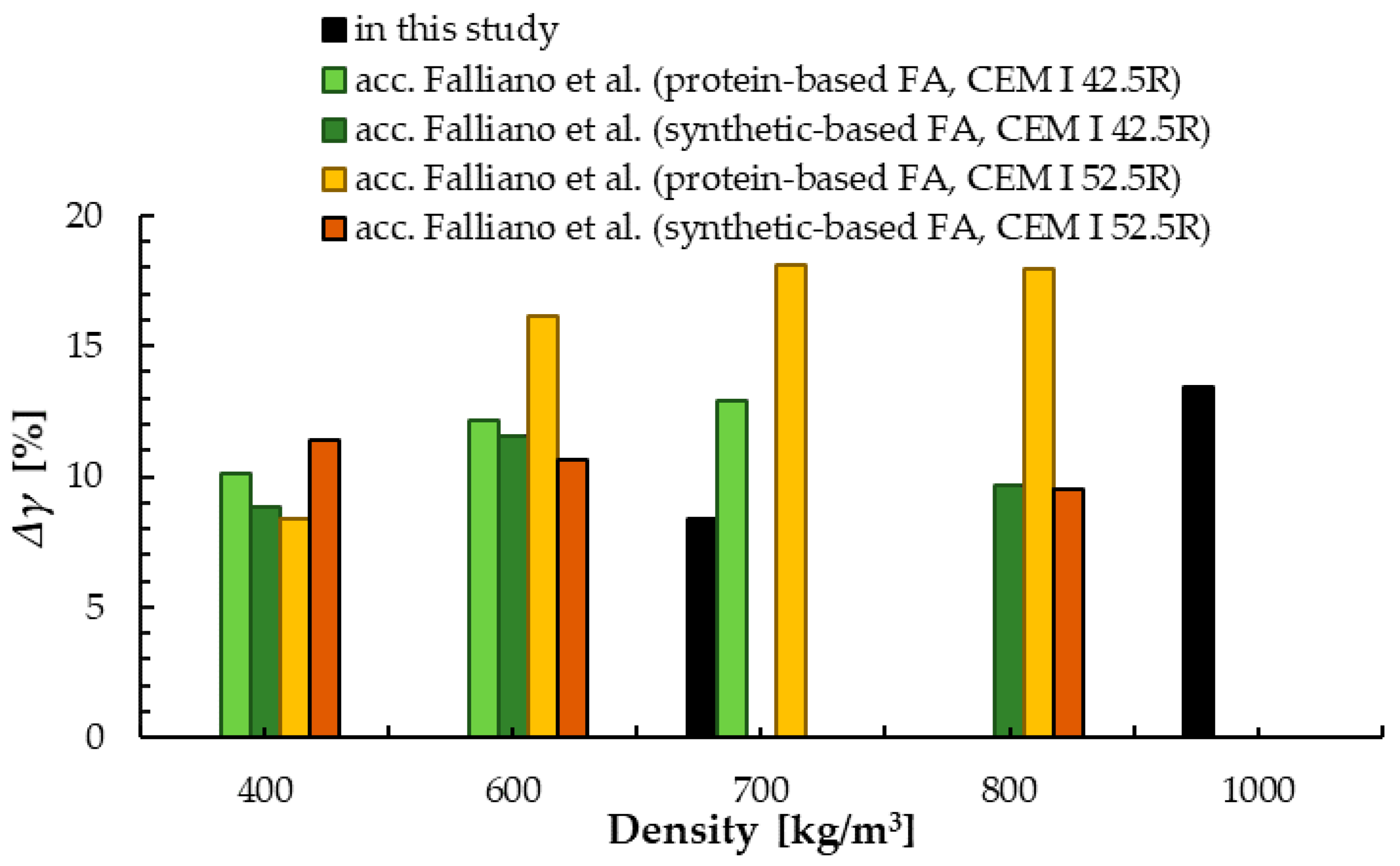
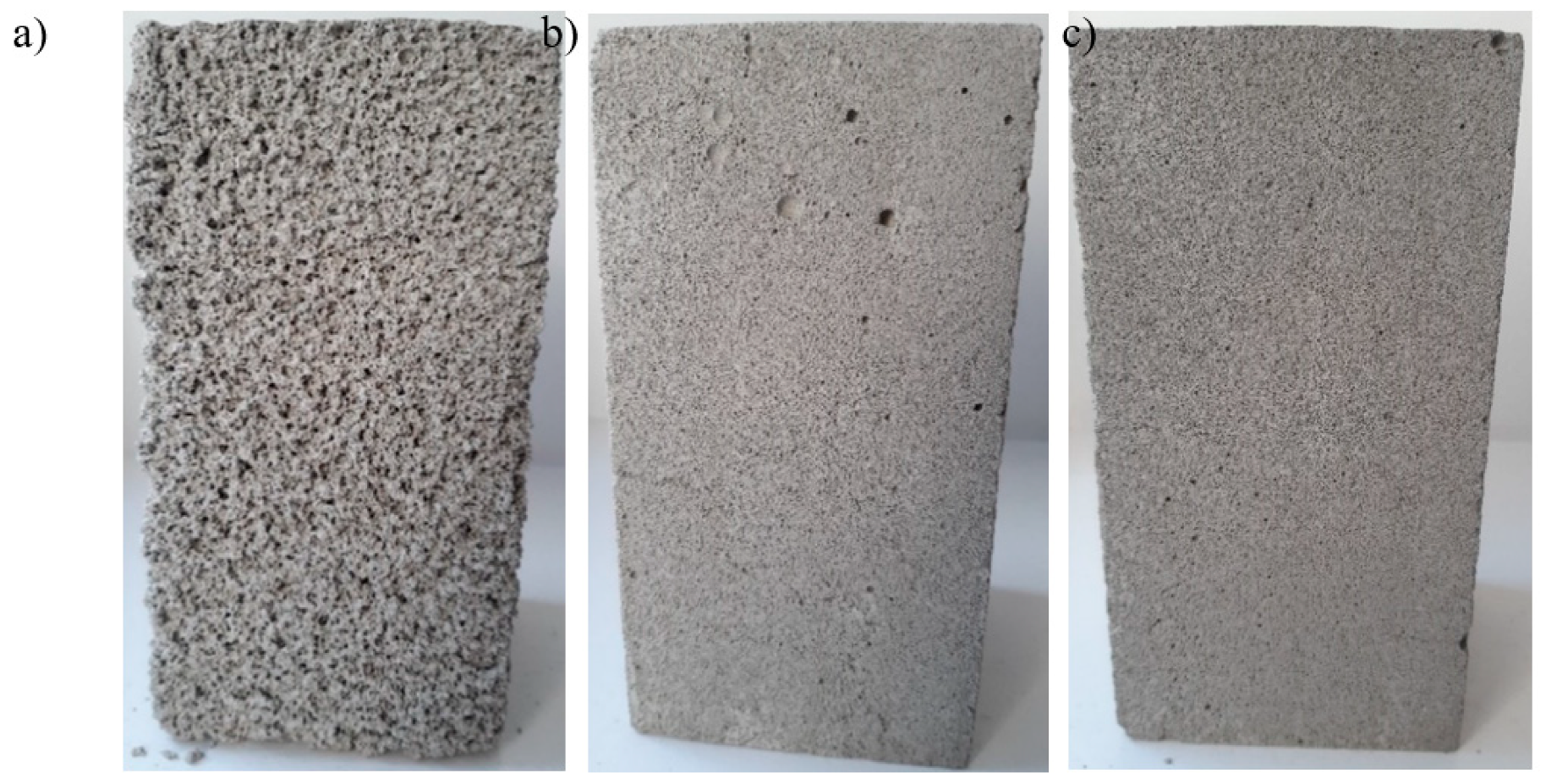
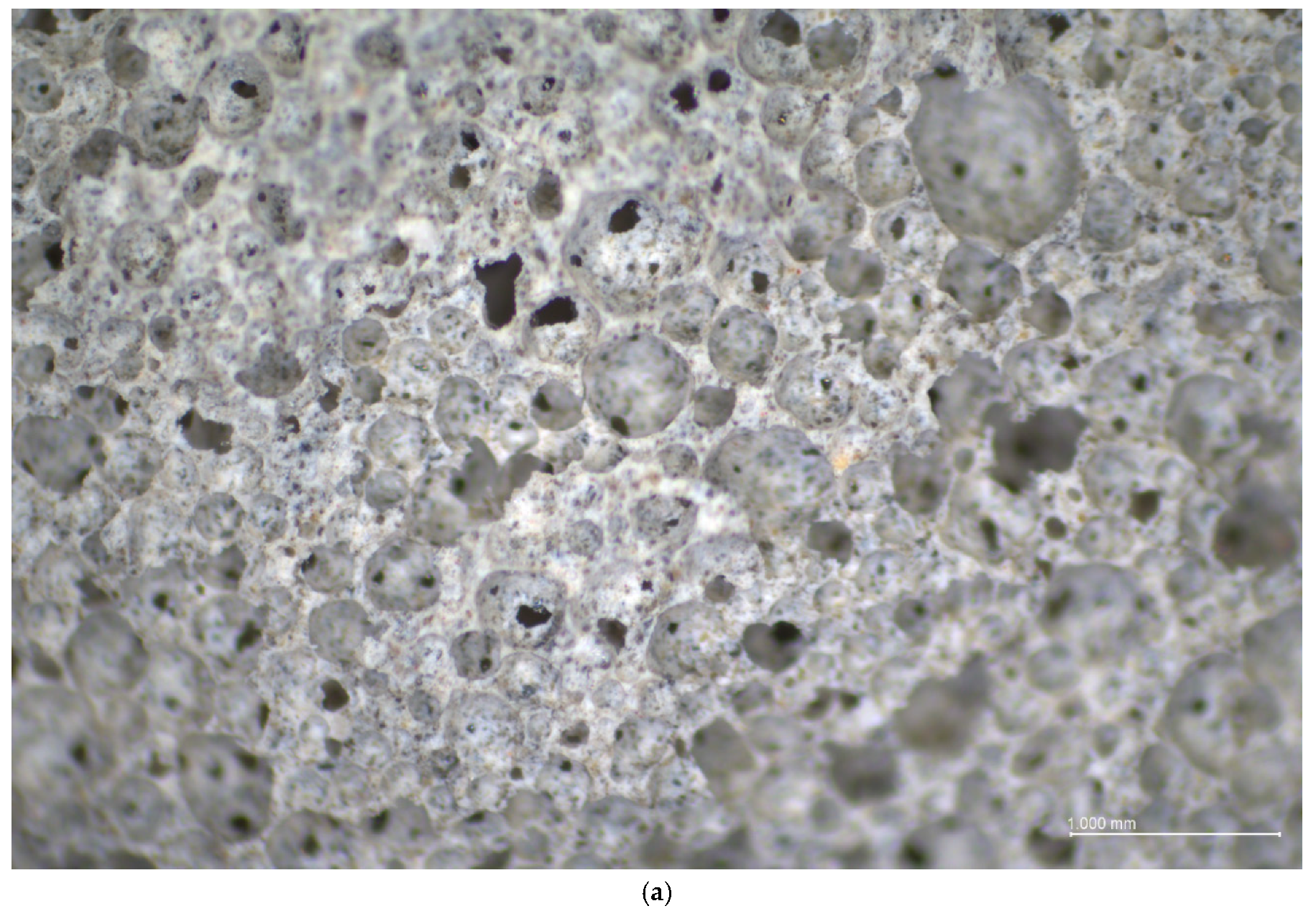
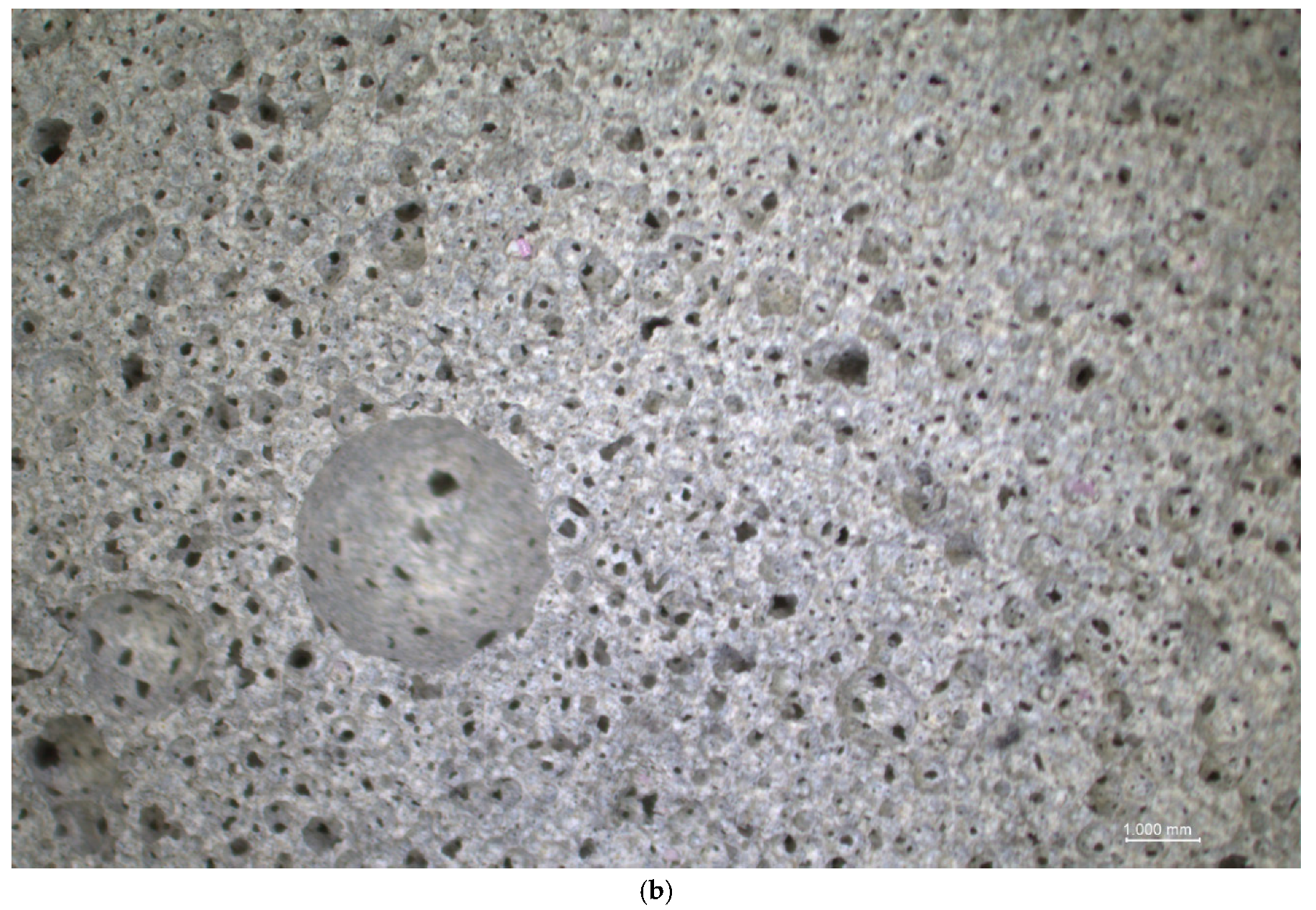
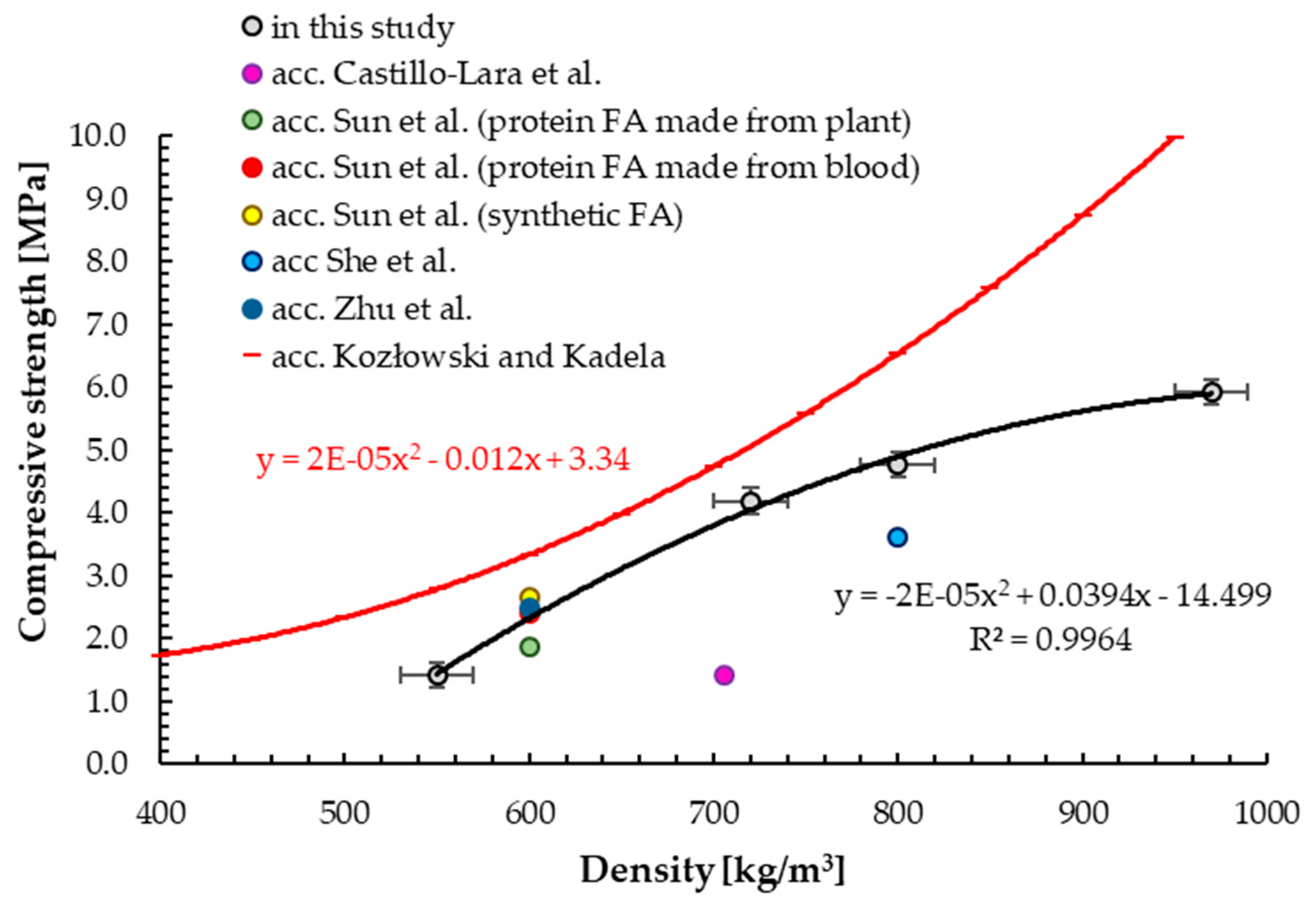
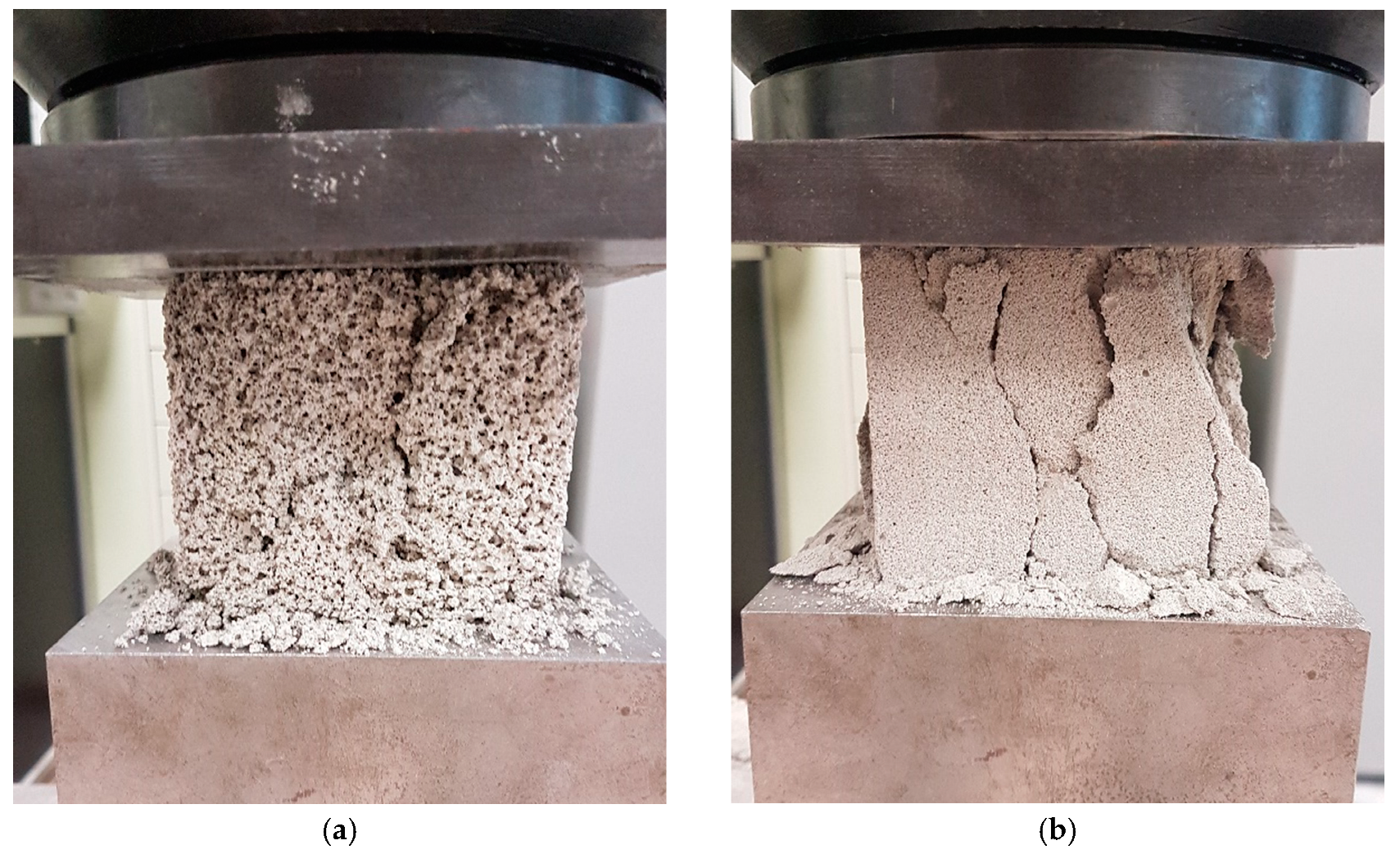
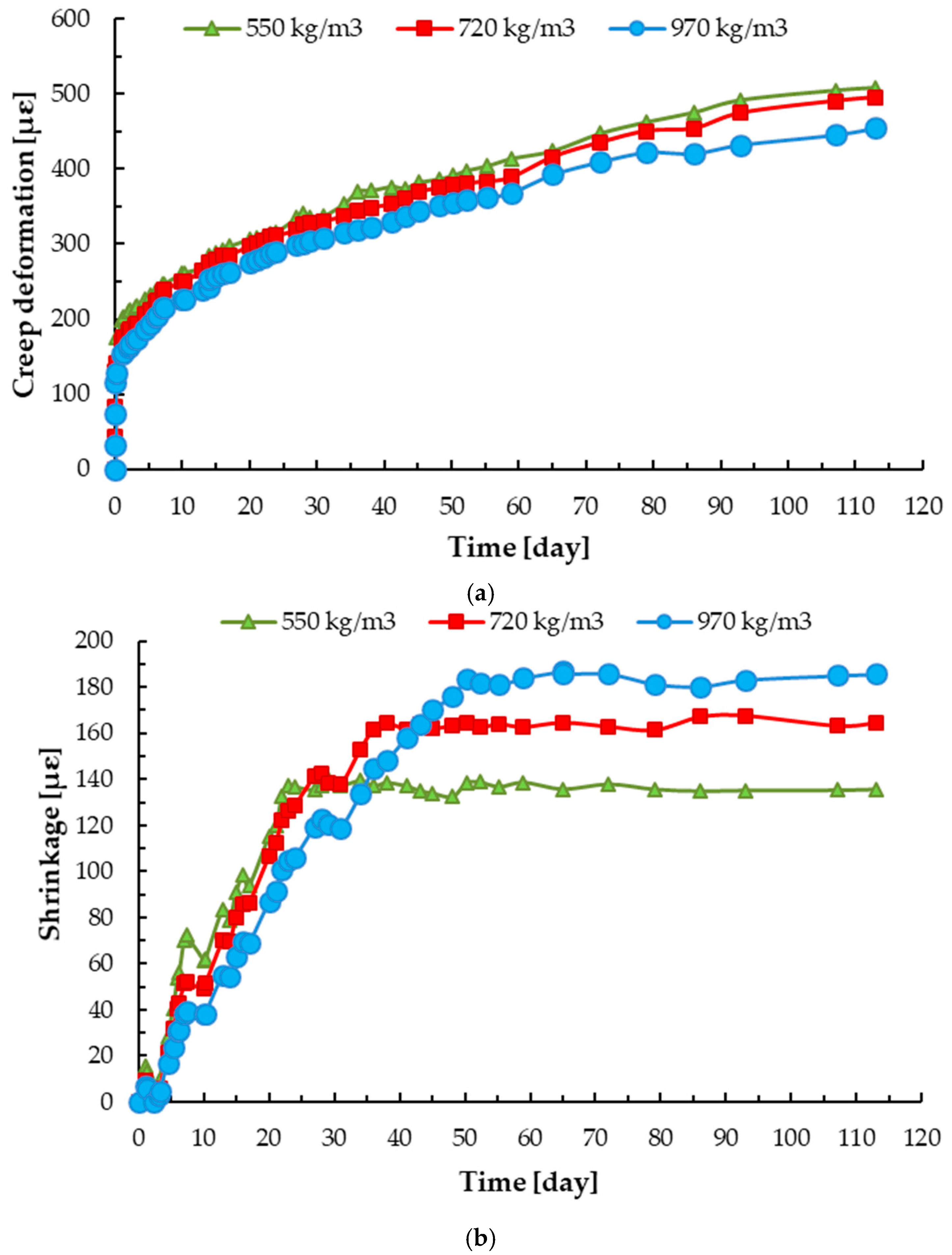
| Chemical | SiO2 | Al2O3 | Fe2O3 | CaO | MgO | SO3 | Na2O | K2O | Cl | LOI | IR |
| Unit (vol. %) | 19.5 | 4.9 | 2.9 | 63.3 | 1.3 | 2.8 | 0.1 | 0.9 | 0.05 | 2.48 | 0.63 |
| Phase | C3S | C2S | C3A | C4AF | |||||||
| Unit (vol. %) | 68 | 4 | 8 | 9 | |||||||
| Specific Surface Area (m2/kg) | Specific Gravity (kg/m3) | Compressive Strength after Days (MPa) | |
|---|---|---|---|
| 2 Days | 28 Days | ||
| 3840 | 3060 | 28.0 | 58.0 |
| Mix Symbol | Cement (kg) | weff/c | Water (kg) | Foaming Agent (dm3 per 100 kg of cement) | Foaming Agent (dm3) |
|---|---|---|---|---|---|
| FC500 | 430 | 0.44 | 155 | 8.0 | 34.4 |
| FC700 | 530 | 201 | 6.0 | 31.8 | |
| FC800 | 610 | 238 | 5.0 | 30.5 | |
| FC1000 | 700 | 280 | 4.0 | 28.0 |
Publisher’s Note: MDPI stays neutral with regard to jurisdictional claims in published maps and institutional affiliations. |
© 2020 by the authors. Licensee MDPI, Basel, Switzerland. This article is an open access article distributed under the terms and conditions of the Creative Commons Attribution (CC BY) license (http://creativecommons.org/licenses/by/4.0/).
Share and Cite
Kadela, M.; Kukiełka, A.; Małek, M. Characteristics of Lightweight Concrete Based on a Synthetic Polymer Foaming Agent. Materials 2020, 13, 4979. https://doi.org/10.3390/ma13214979
Kadela M, Kukiełka A, Małek M. Characteristics of Lightweight Concrete Based on a Synthetic Polymer Foaming Agent. Materials. 2020; 13(21):4979. https://doi.org/10.3390/ma13214979
Chicago/Turabian StyleKadela, Marta, Alfred Kukiełka, and Marcin Małek. 2020. "Characteristics of Lightweight Concrete Based on a Synthetic Polymer Foaming Agent" Materials 13, no. 21: 4979. https://doi.org/10.3390/ma13214979
APA StyleKadela, M., Kukiełka, A., & Małek, M. (2020). Characteristics of Lightweight Concrete Based on a Synthetic Polymer Foaming Agent. Materials, 13(21), 4979. https://doi.org/10.3390/ma13214979







